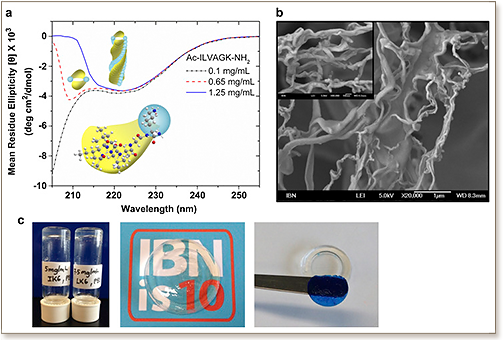
Ultrashort peptide nanofibrous hydrogels for the acceleration of healing of burn wounds
Y. Loo, Y.C. Wong, E.Z. Cai, C.H. Ang, A. Raju, A. Lakshmanan, A.G.W. Koh, H.J. Zhou, T.C. Lim, S.M. Moochhala, and C.A.E. Hauser
Biomaterials, 35 (2014) 4805-14

There is an unmet clinical need for wound dressings to treat partial thickness burns that damage the epidermis and dermis. An ideal dressing needs to prevent infection, maintain skin hydration to facilitate debridement of the necrotic tissue, and provide cues to enhance tissue regeneration. We developed a class of 'smart' peptide hydrogels, which fulfill these criteria. Our ultrashort aliphatic peptides have an innate tendency to self-assemble into helical fibers, forming biomimetic hydrogel scaffolds which are non-immunogenic and non-cytotoxic. These nanofibrous hydrogels accelerated wound closure in a rat model for partial thickness burns. Two peptide hydrogel candidates demonstrate earlier onset and completion of autolytic debridement, compared to Mepitel (R), a silicone-coated polyamide net used as standard-of-care. They also promote epithelial and dermal regeneration in the absence of exogenous growth factors, achieving 86.2% and 92.9% wound closure respectively, after 14 days. In comparison, only 62.8% of the burnt area is healed for wounds dressed with Mepitel. Since the rate of wound closure is inversely correlated with hypertrophic scar formation and infection risks, our peptide hydrogel technology fills a niche neglected by current treatment options. The regenerative properties can be further enhanced by incorporation of bioactive moieties such as growth factors and cytokines.
DOI: 10.1016/j.biomaterials.2014.02.047

"KAUST shall be a beacon for peace, hope and reconciliation, and shall serve the people of the Kingdom and the world."
King Abdullah bin Abdulaziz Al Saud, 1924 – 2015
Thuwal 23955-6900, Kingdom of Saudi Arabia
Al-Haytham Building (Bldg. 2)
© King Abdullah University of Science and Technology. All rights reserved